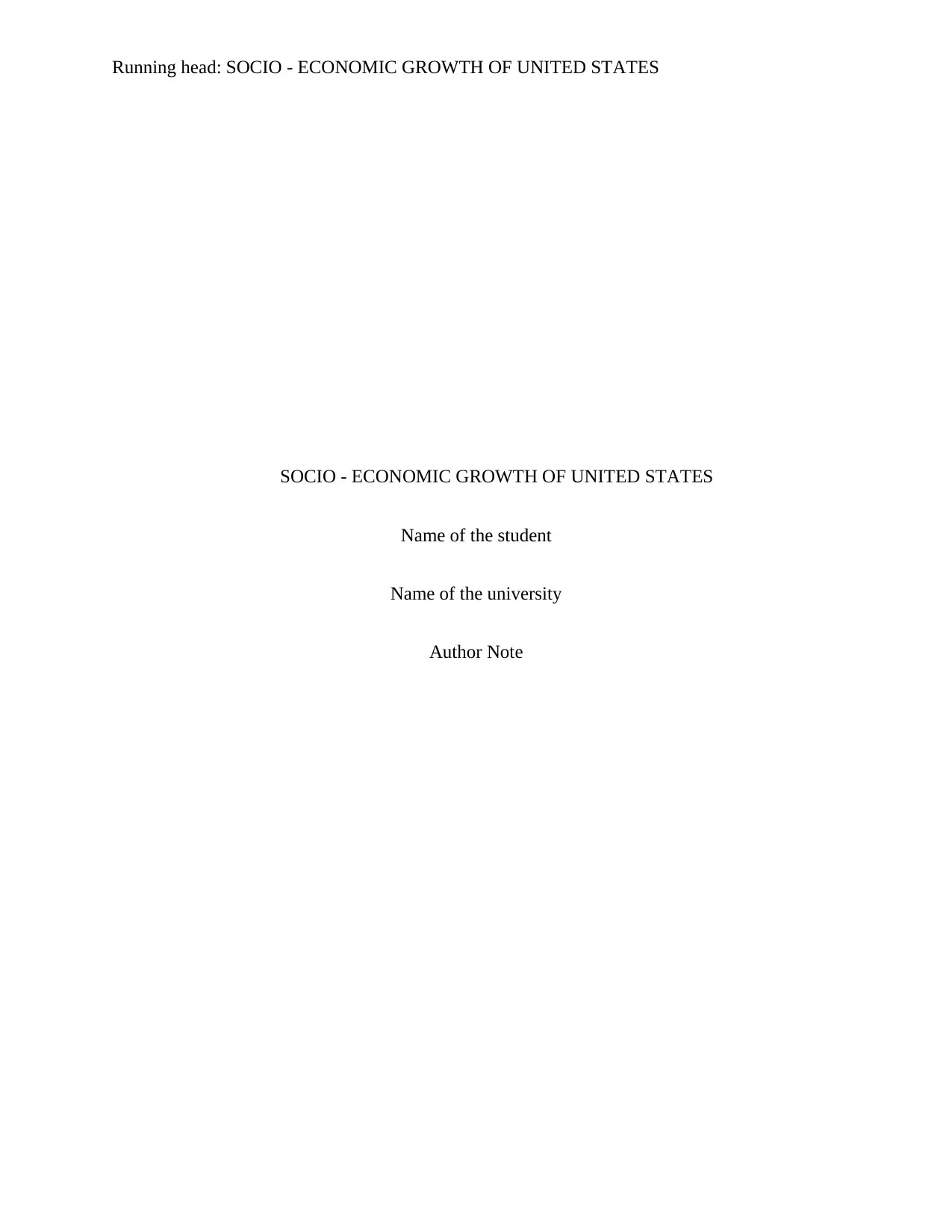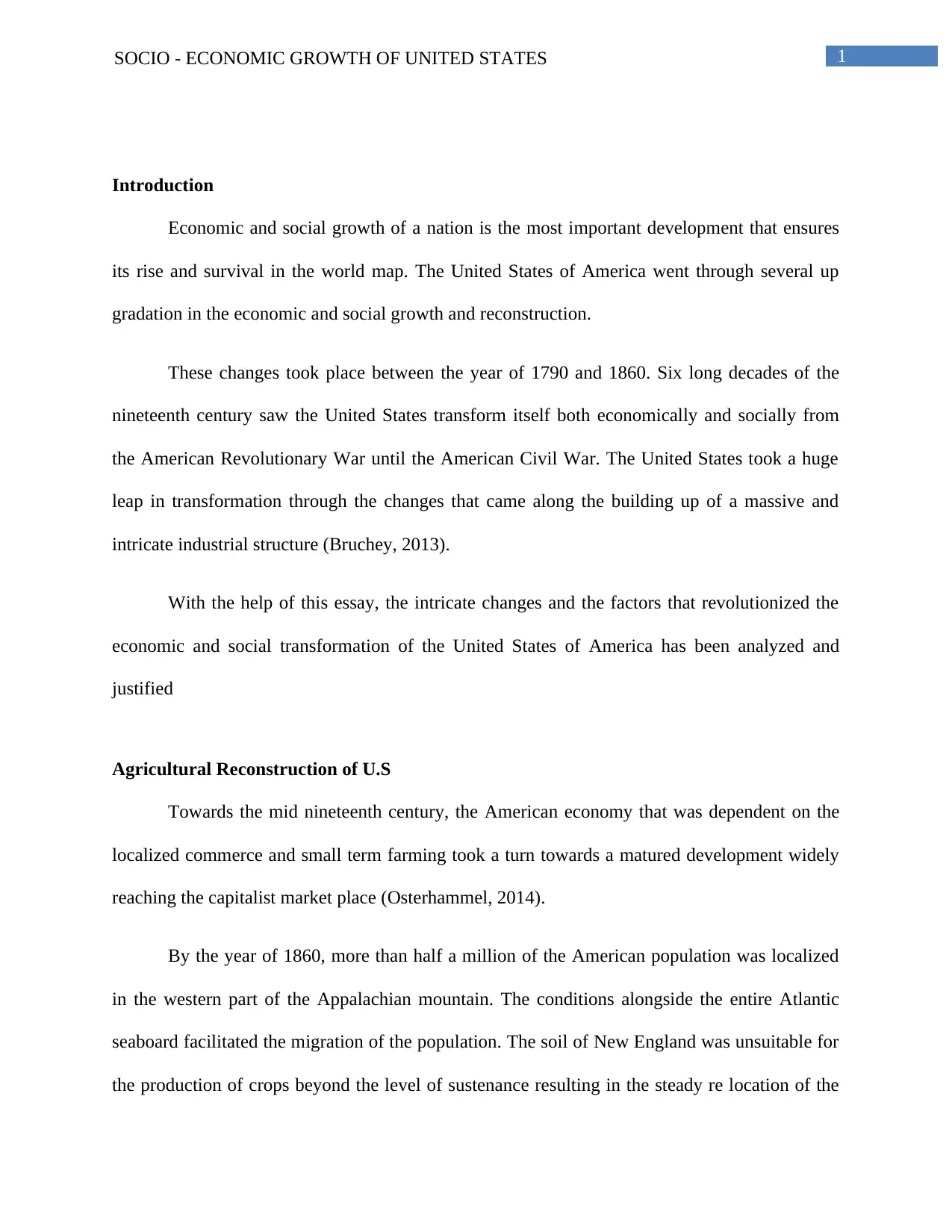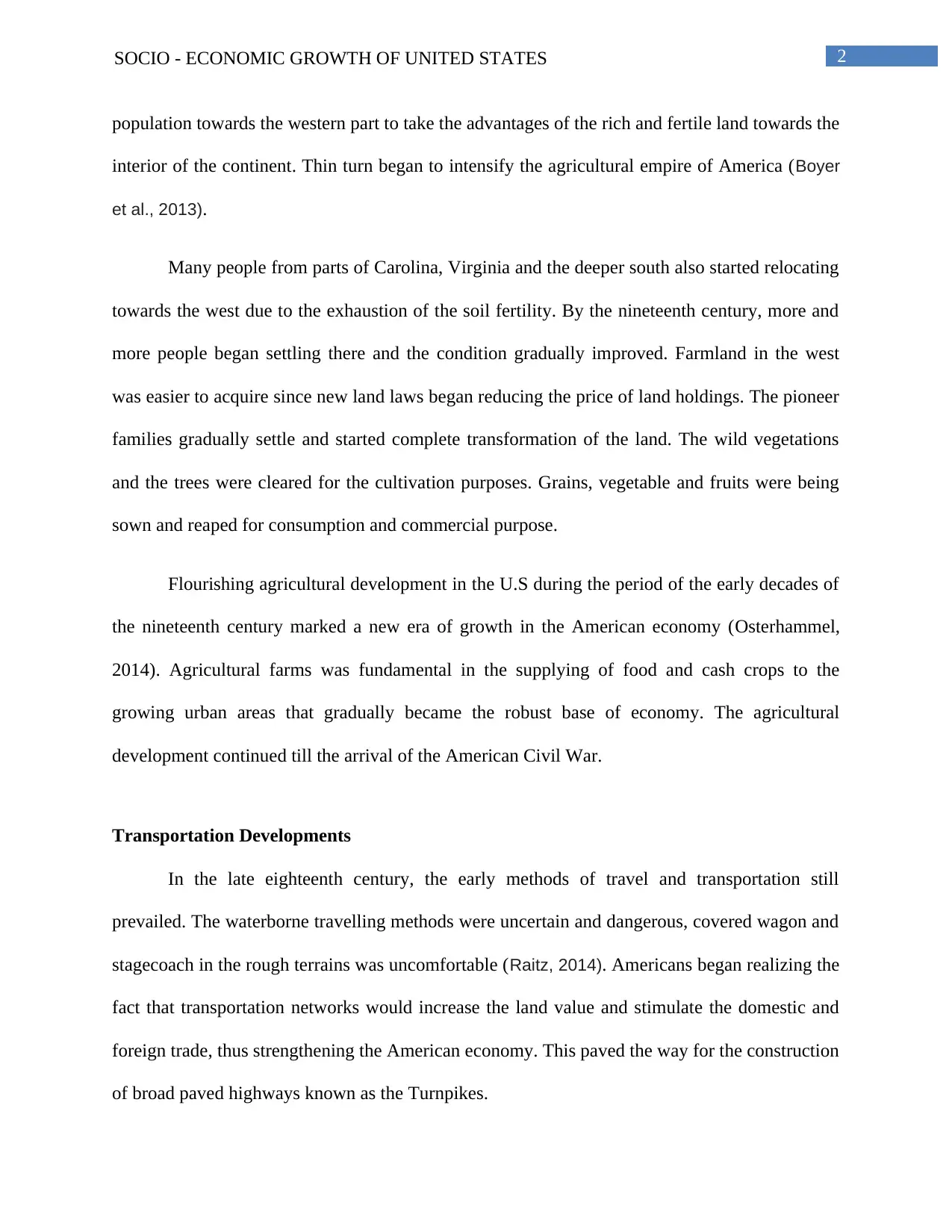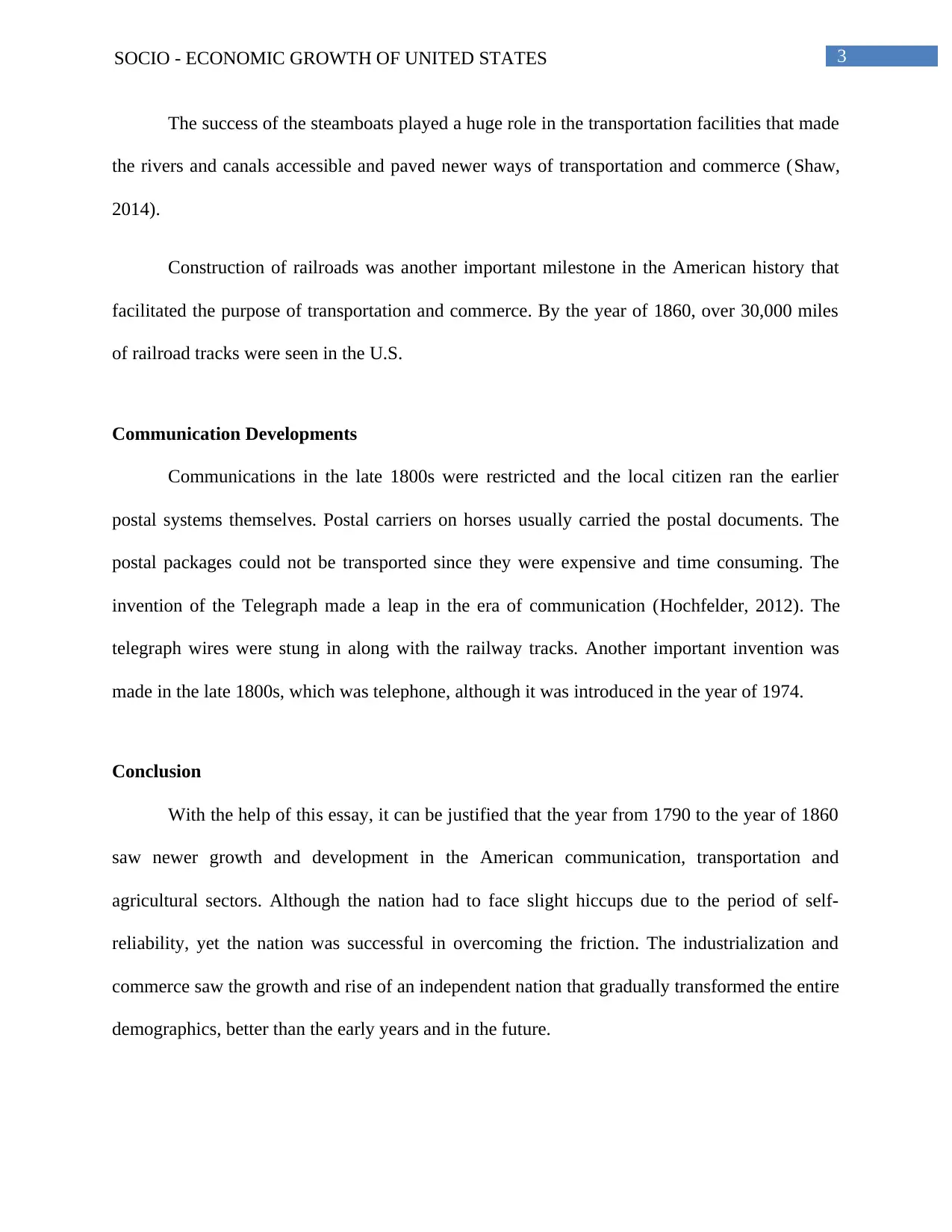Factors Driving Socio-Economic Growth in the United States (1790-1860)
VerifiedAdded on 2020/03/16
|5
|1026
|126
Essay
AI Summary
This essay delves into the socio-economic transformation of the United States between 1790 and 1860, a period marked by significant changes in agriculture, transportation, and communication. The analysis highlights the shift from localized commerce to a capitalist market, focusing on agricultural advancements, including land acquisition and crop production. The essay also examines the evolution of transportation, from early methods to the development of turnpikes, steamboats, and railroads, which facilitated trade and economic growth. Furthermore, it explores the advancements in communication, particularly the invention of the telegraph, which revolutionized information dissemination. The conclusion emphasizes the growth and development across these sectors, highlighting the nation's ability to overcome challenges and transform its demographics, laying the foundation for future progress.

Running head: SOCIO - ECONOMIC GROWTH OF UNITED STATES
SOCIO - ECONOMIC GROWTH OF UNITED STATES
Name of the student
Name of the university
Author Note
SOCIO - ECONOMIC GROWTH OF UNITED STATES
Name of the student
Name of the university
Author Note
Paraphrase This Document
Need a fresh take? Get an instant paraphrase of this document with our AI Paraphraser

1SOCIO - ECONOMIC GROWTH OF UNITED STATES
Introduction
Economic and social growth of a nation is the most important development that ensures
its rise and survival in the world map. The United States of America went through several up
gradation in the economic and social growth and reconstruction.
These changes took place between the year of 1790 and 1860. Six long decades of the
nineteenth century saw the United States transform itself both economically and socially from
the American Revolutionary War until the American Civil War. The United States took a huge
leap in transformation through the changes that came along the building up of a massive and
intricate industrial structure (Bruchey, 2013).
With the help of this essay, the intricate changes and the factors that revolutionized the
economic and social transformation of the United States of America has been analyzed and
justified
Agricultural Reconstruction of U.S
Towards the mid nineteenth century, the American economy that was dependent on the
localized commerce and small term farming took a turn towards a matured development widely
reaching the capitalist market place (Osterhammel, 2014).
By the year of 1860, more than half a million of the American population was localized
in the western part of the Appalachian mountain. The conditions alongside the entire Atlantic
seaboard facilitated the migration of the population. The soil of New England was unsuitable for
the production of crops beyond the level of sustenance resulting in the steady re location of the
Introduction
Economic and social growth of a nation is the most important development that ensures
its rise and survival in the world map. The United States of America went through several up
gradation in the economic and social growth and reconstruction.
These changes took place between the year of 1790 and 1860. Six long decades of the
nineteenth century saw the United States transform itself both economically and socially from
the American Revolutionary War until the American Civil War. The United States took a huge
leap in transformation through the changes that came along the building up of a massive and
intricate industrial structure (Bruchey, 2013).
With the help of this essay, the intricate changes and the factors that revolutionized the
economic and social transformation of the United States of America has been analyzed and
justified
Agricultural Reconstruction of U.S
Towards the mid nineteenth century, the American economy that was dependent on the
localized commerce and small term farming took a turn towards a matured development widely
reaching the capitalist market place (Osterhammel, 2014).
By the year of 1860, more than half a million of the American population was localized
in the western part of the Appalachian mountain. The conditions alongside the entire Atlantic
seaboard facilitated the migration of the population. The soil of New England was unsuitable for
the production of crops beyond the level of sustenance resulting in the steady re location of the

2SOCIO - ECONOMIC GROWTH OF UNITED STATES
population towards the western part to take the advantages of the rich and fertile land towards the
interior of the continent. Thin turn began to intensify the agricultural empire of America (Boyer
et al., 2013).
Many people from parts of Carolina, Virginia and the deeper south also started relocating
towards the west due to the exhaustion of the soil fertility. By the nineteenth century, more and
more people began settling there and the condition gradually improved. Farmland in the west
was easier to acquire since new land laws began reducing the price of land holdings. The pioneer
families gradually settle and started complete transformation of the land. The wild vegetations
and the trees were cleared for the cultivation purposes. Grains, vegetable and fruits were being
sown and reaped for consumption and commercial purpose.
Flourishing agricultural development in the U.S during the period of the early decades of
the nineteenth century marked a new era of growth in the American economy (Osterhammel,
2014). Agricultural farms was fundamental in the supplying of food and cash crops to the
growing urban areas that gradually became the robust base of economy. The agricultural
development continued till the arrival of the American Civil War.
Transportation Developments
In the late eighteenth century, the early methods of travel and transportation still
prevailed. The waterborne travelling methods were uncertain and dangerous, covered wagon and
stagecoach in the rough terrains was uncomfortable (Raitz, 2014). Americans began realizing the
fact that transportation networks would increase the land value and stimulate the domestic and
foreign trade, thus strengthening the American economy. This paved the way for the construction
of broad paved highways known as the Turnpikes.
population towards the western part to take the advantages of the rich and fertile land towards the
interior of the continent. Thin turn began to intensify the agricultural empire of America (Boyer
et al., 2013).
Many people from parts of Carolina, Virginia and the deeper south also started relocating
towards the west due to the exhaustion of the soil fertility. By the nineteenth century, more and
more people began settling there and the condition gradually improved. Farmland in the west
was easier to acquire since new land laws began reducing the price of land holdings. The pioneer
families gradually settle and started complete transformation of the land. The wild vegetations
and the trees were cleared for the cultivation purposes. Grains, vegetable and fruits were being
sown and reaped for consumption and commercial purpose.
Flourishing agricultural development in the U.S during the period of the early decades of
the nineteenth century marked a new era of growth in the American economy (Osterhammel,
2014). Agricultural farms was fundamental in the supplying of food and cash crops to the
growing urban areas that gradually became the robust base of economy. The agricultural
development continued till the arrival of the American Civil War.
Transportation Developments
In the late eighteenth century, the early methods of travel and transportation still
prevailed. The waterborne travelling methods were uncertain and dangerous, covered wagon and
stagecoach in the rough terrains was uncomfortable (Raitz, 2014). Americans began realizing the
fact that transportation networks would increase the land value and stimulate the domestic and
foreign trade, thus strengthening the American economy. This paved the way for the construction
of broad paved highways known as the Turnpikes.
⊘ This is a preview!⊘
Do you want full access?
Subscribe today to unlock all pages.

Trusted by 1+ million students worldwide

3SOCIO - ECONOMIC GROWTH OF UNITED STATES
The success of the steamboats played a huge role in the transportation facilities that made
the rivers and canals accessible and paved newer ways of transportation and commerce (Shaw,
2014).
Construction of railroads was another important milestone in the American history that
facilitated the purpose of transportation and commerce. By the year of 1860, over 30,000 miles
of railroad tracks were seen in the U.S.
Communication Developments
Communications in the late 1800s were restricted and the local citizen ran the earlier
postal systems themselves. Postal carriers on horses usually carried the postal documents. The
postal packages could not be transported since they were expensive and time consuming. The
invention of the Telegraph made a leap in the era of communication (Hochfelder, 2012). The
telegraph wires were stung in along with the railway tracks. Another important invention was
made in the late 1800s, which was telephone, although it was introduced in the year of 1974.
Conclusion
With the help of this essay, it can be justified that the year from 1790 to the year of 1860
saw newer growth and development in the American communication, transportation and
agricultural sectors. Although the nation had to face slight hiccups due to the period of self-
reliability, yet the nation was successful in overcoming the friction. The industrialization and
commerce saw the growth and rise of an independent nation that gradually transformed the entire
demographics, better than the early years and in the future.
The success of the steamboats played a huge role in the transportation facilities that made
the rivers and canals accessible and paved newer ways of transportation and commerce (Shaw,
2014).
Construction of railroads was another important milestone in the American history that
facilitated the purpose of transportation and commerce. By the year of 1860, over 30,000 miles
of railroad tracks were seen in the U.S.
Communication Developments
Communications in the late 1800s were restricted and the local citizen ran the earlier
postal systems themselves. Postal carriers on horses usually carried the postal documents. The
postal packages could not be transported since they were expensive and time consuming. The
invention of the Telegraph made a leap in the era of communication (Hochfelder, 2012). The
telegraph wires were stung in along with the railway tracks. Another important invention was
made in the late 1800s, which was telephone, although it was introduced in the year of 1974.
Conclusion
With the help of this essay, it can be justified that the year from 1790 to the year of 1860
saw newer growth and development in the American communication, transportation and
agricultural sectors. Although the nation had to face slight hiccups due to the period of self-
reliability, yet the nation was successful in overcoming the friction. The industrialization and
commerce saw the growth and rise of an independent nation that gradually transformed the entire
demographics, better than the early years and in the future.
Paraphrase This Document
Need a fresh take? Get an instant paraphrase of this document with our AI Paraphraser

4SOCIO - ECONOMIC GROWTH OF UNITED STATES
References
Boyer, P. S., Clark, C. E., Halttunen, K., Kett, J. F., & Salisbury, N. (2013). The enduring vision:
A history of the American people. Cengage Learning.
Bruchey, S. (2013). Roots of American Economic Growth 1607-1861: An Essay on Social
Causation. Routledge.
Hochfelder, D. (2012). The telegraph in America, 1832–1920. JHU Press.
Osterhammel, J. (2014). The transformation of the world: a global history of the nineteenth
century. Princeton University Press.
Raitz, K. (2014). Making Connections via Roads, Rivers, Canals, and Rails. North American
Odyssey: Historical Geographies for the Twenty-first Century, 117.
Shaw, R. E. (2014). Canals for a nation: the canal era in the United States, 1790-1860. University
Press of Kentucky.
References
Boyer, P. S., Clark, C. E., Halttunen, K., Kett, J. F., & Salisbury, N. (2013). The enduring vision:
A history of the American people. Cengage Learning.
Bruchey, S. (2013). Roots of American Economic Growth 1607-1861: An Essay on Social
Causation. Routledge.
Hochfelder, D. (2012). The telegraph in America, 1832–1920. JHU Press.
Osterhammel, J. (2014). The transformation of the world: a global history of the nineteenth
century. Princeton University Press.
Raitz, K. (2014). Making Connections via Roads, Rivers, Canals, and Rails. North American
Odyssey: Historical Geographies for the Twenty-first Century, 117.
Shaw, R. E. (2014). Canals for a nation: the canal era in the United States, 1790-1860. University
Press of Kentucky.
1 out of 5
Related Documents
Your All-in-One AI-Powered Toolkit for Academic Success.
+13062052269
info@desklib.com
Available 24*7 on WhatsApp / Email
![[object Object]](/_next/static/media/star-bottom.7253800d.svg)
Unlock your academic potential
Copyright © 2020–2025 A2Z Services. All Rights Reserved. Developed and managed by ZUCOL.





